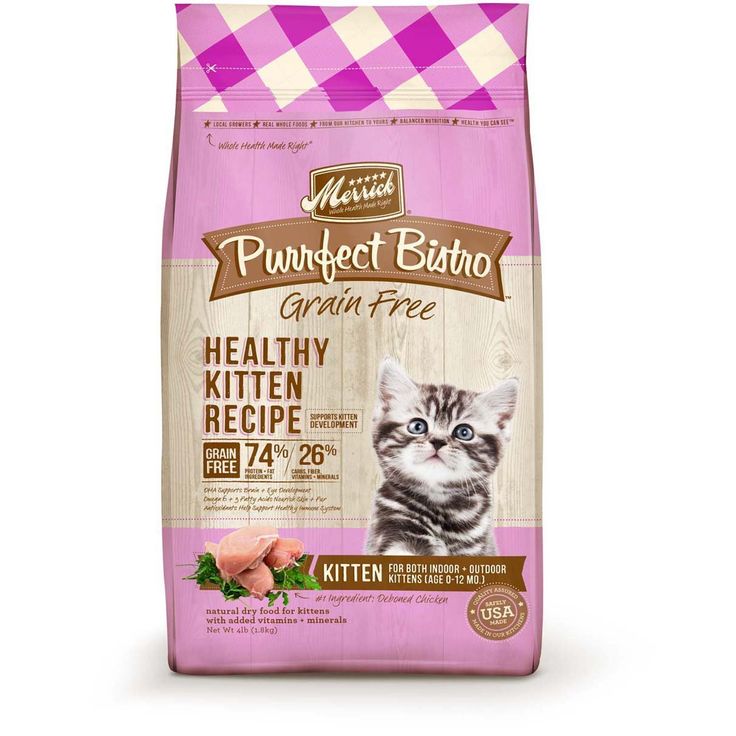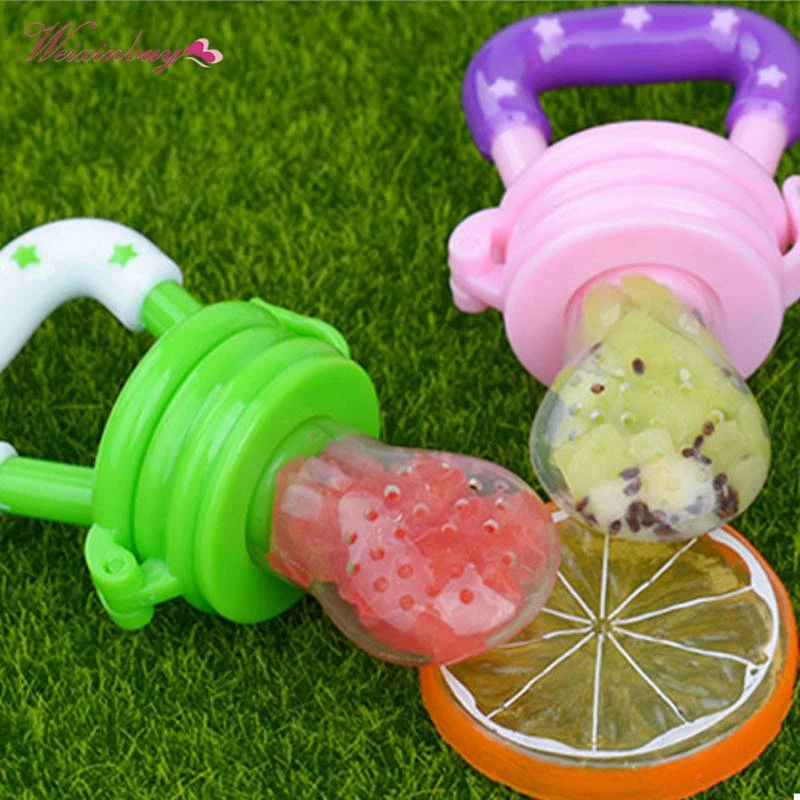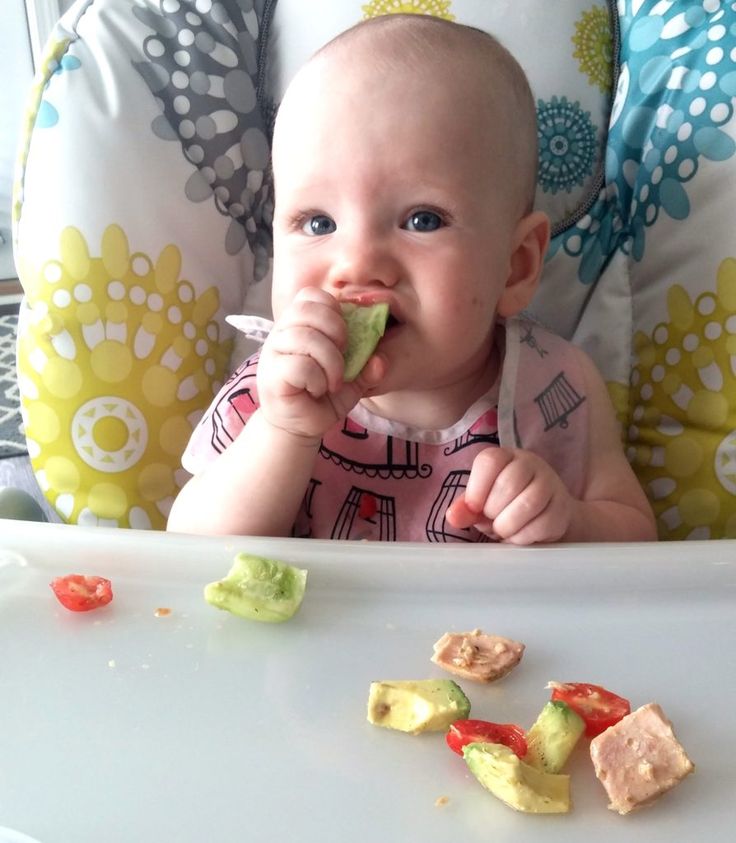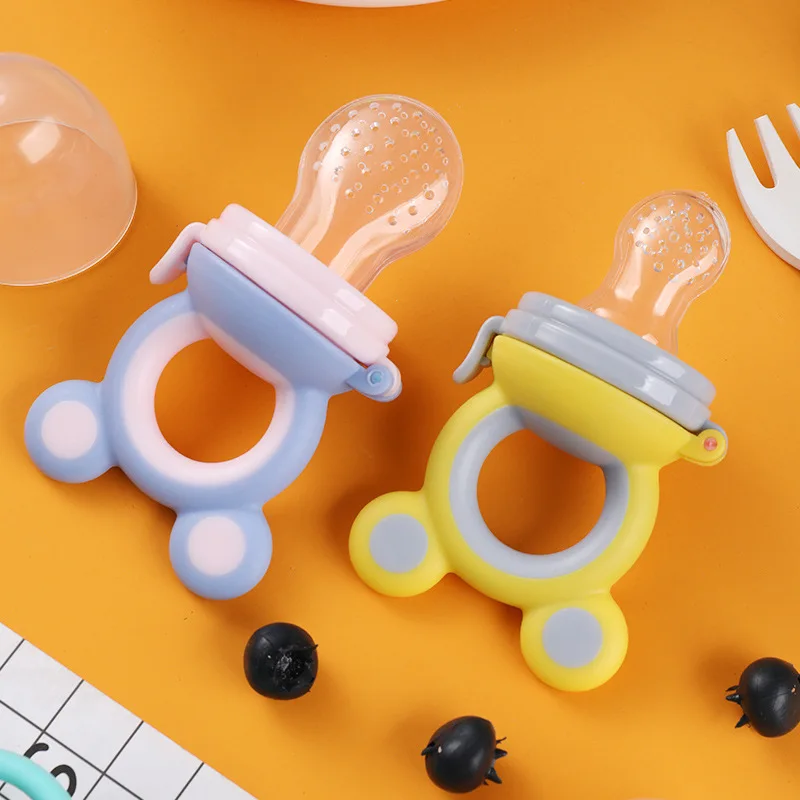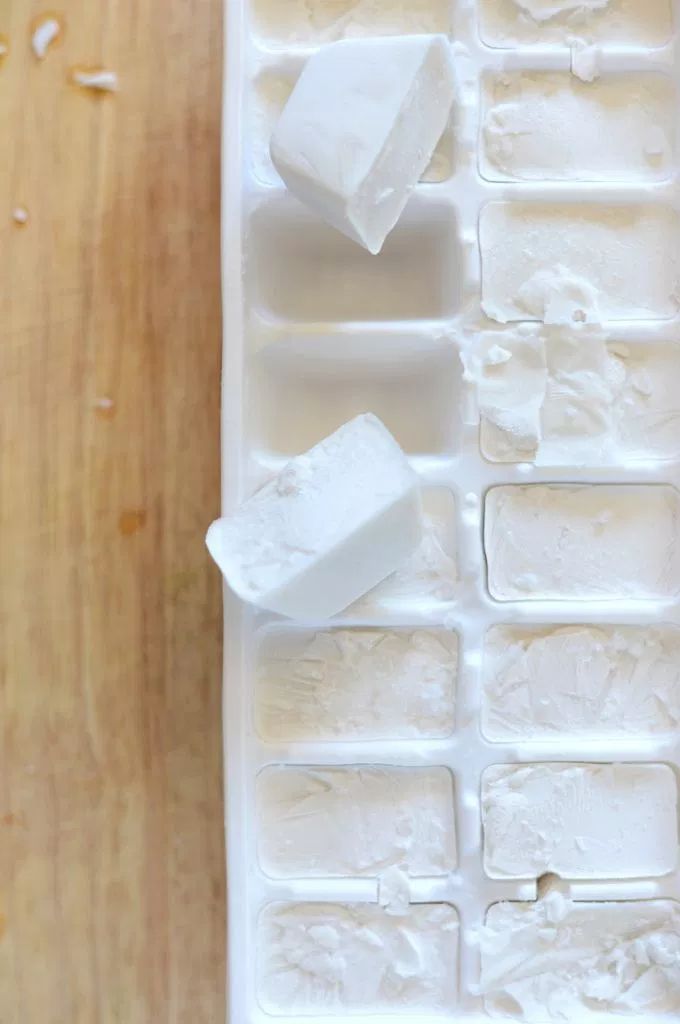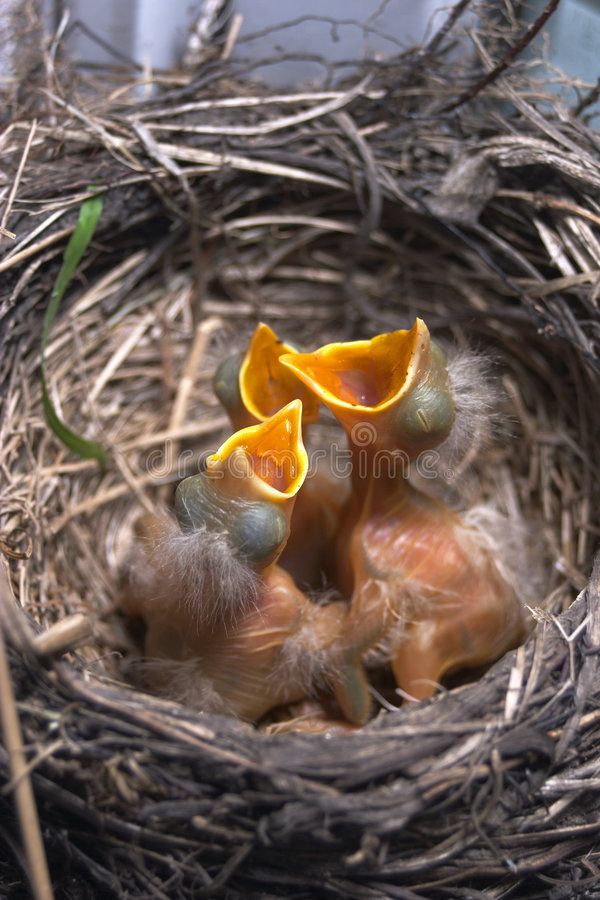When can baby kittens eat dry food
Kitten Feeding Week by Week
Image
Feeding orphaned kittens can feel like a full-time job, especially in the beginning when they need to be fed the most. But it’s also incredibly rewarding, and before you know it, your kittens will be eating on their own and soon ready to find homes. The feeding protocols below are provided by the Kitten Nursery of Salt Lake County Animal Services, in partnership with Best Friends Animal Society–Utah.
Kittens one week old or less: Bottle-feeding
- Food type: Formula
- Frequency: Every 2 – 3 hours (8 – 12 times per day)
- Amount: 3 – 4 cc per feeding
Two-week-old kittens: Bottle-feeding
- Food type: Formula
- Frequency: Every 3 hours (8 times per day)
- Amount: 5 – 6 cc per feeding
Three- to four-week-old kittens: Bottle-feeding
- Food type: Formula
- Frequency: Every 4 hours (6 times per day)
- Amount: 13 – 17 cc per feeding
Four-week-old kittens: Begin feeding gruel – Weaning stage
- Food type: 1/2 can per kitten of gruel (gruel instructions below) in a dish and dry kitten food in a dish, and dish full of water at all times.
Plus formula three times per day.
- Frequency: Keep kibble, water and gruel in cage at all times.
- Give 13 – 17 cc of formula every 8 hours (3 times per day).
- During bottle-feeding sessions, try to get the kittens to also eat gruel off a spoon or tongue depressor and from a dish (see instructions on making gruel for more tips). It is important to start getting small amounts of gruel into their stomachs.
- Note: At this time, also introduce litter box; kittens can eliminate on their own at this age and do not need to be stimulated to go anymore.
How to mix gruel
Small batch (for one kitten): ½ can of wet kitten food mixed with ¼ can of formula (use an empty food can as a measuring cup).
Large batch: Whisk 8 cans wet kitten food with 4 cans of fresh, warm formula (use the empty food can as a measuring cup). At this age, kittens like their food a little lumpy so they can chew.
Note: Substitute the warm water for formula in gruel for kittens 5 weeks and older.
Helpful tips when using gruel:
- When introducing kittens to gruel, put gruel in a flat dish and place kittens near the dish. If they do not start to eat on their own after a few minutes, use tongue depressor or spoon to scoop gruel into kitten’s mouth. You may have to open their mouth and put a little in. You can also put a little gruel on their nose and see if they will lick it off. Sometimes the kittens need to adjust to the new taste.
- Once kitten starts to eat gruel off the spoon or tongue depressor (may take a few feedings for them to figure this step out), slowly start to lower it towards the dish of gruel. The kittens should easily transition from the spoon or depressor to the dish (may take a day for them to start eating out of the dish regularly).
- During the weaning process, kittens still need to be bottle-fed three times per day (about every 8 hours) to ensure they are receiving proper nutrients.
Five- to eight-week-old kittens: Solid food
Food type: ½ can per kitten of kibble in a dish and wet food in a dish at all times, and a dish full of water at all times
- Kittens 3 to 5 weeks should be given baby cat kibble.
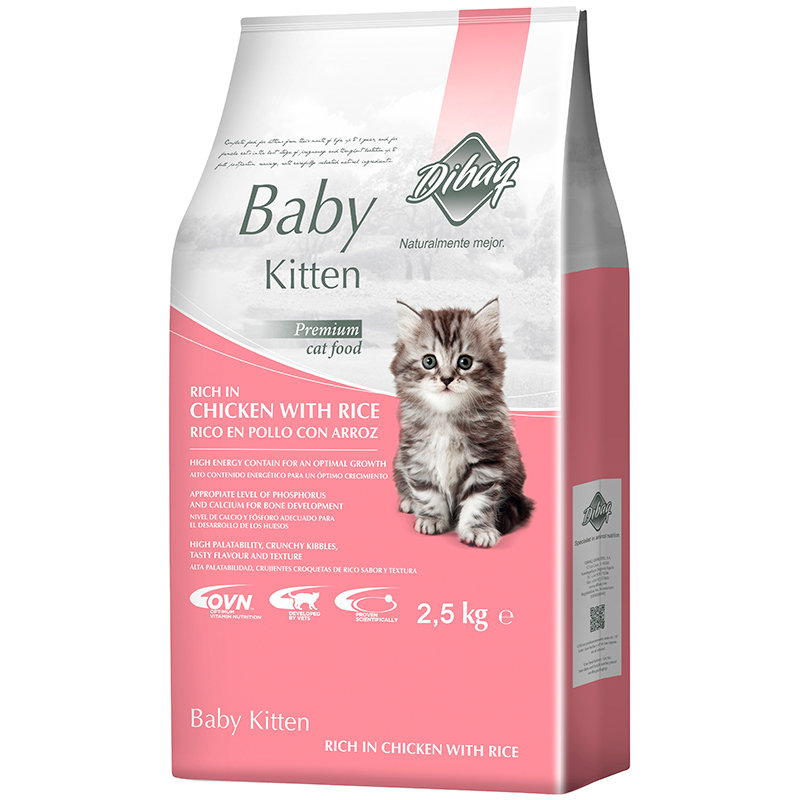
- Kittens 5 to 6 weeks should be given kitten kibble and kibble should be mixed into the wet food.
- Kittens 7 weeks and older should eat mainly dry kibble.
- Weeks 5 and 6 are transition weeks where the two foods (what they were eating and what they will be eating) should be mixed together so their tummies do not get upset by the change in diet. Gradually decrease the amount of food they were eating while increasing what they will be eating over the course of 7 days.
Spay or neuter and adoption
Eight-week-old healthy kittens are fully weaned and should soon be ready to be spayed or neutered and to find their new forever homes. It is much easier to find homes for eight-week old kittens than it is if you wait longer, so start setting a plan early on. Sharing photos of the kittens with friends and family as they grow, and telling everyone you know that you’ll be looking for homes for the kittens is a great way to find homes. For more advice on finding homes for the kittens, see this guide on finding homes for homeless pets.
It is also important to ensure that all the kittens are spayed or neutered, so they don’t accidentally add to the thousands of unplanned litters of kittens that enter shelters each year. Find a low-cost spay/neuter clinic near you.
While caring for orphaned kittens is a lot of work, it’s also a lot of fun. The most rewarding part is watching your charges grow up and go into new homes. And the best part is that you can feel good knowing that you helped keep kittens — the most at-risk animals to enter shelters — safe and sound.
More about abandoned baby kitten care
Note: This article is the last in a four-part series on caring for baby kittens who are abandoned.
Photos by Sarah Ause Kichas
Categories:
CatCaring for Pets
Find Out When You Can Feed Kittens Dry Food in This Guide
PawTracks may earn a commission when you buy through links on our site.
Tips on feeding your new kitten
By Mary Johnson
Caring for kittens is hard work, but it’s ultimately one of the most rewarding experiences of a lifetime.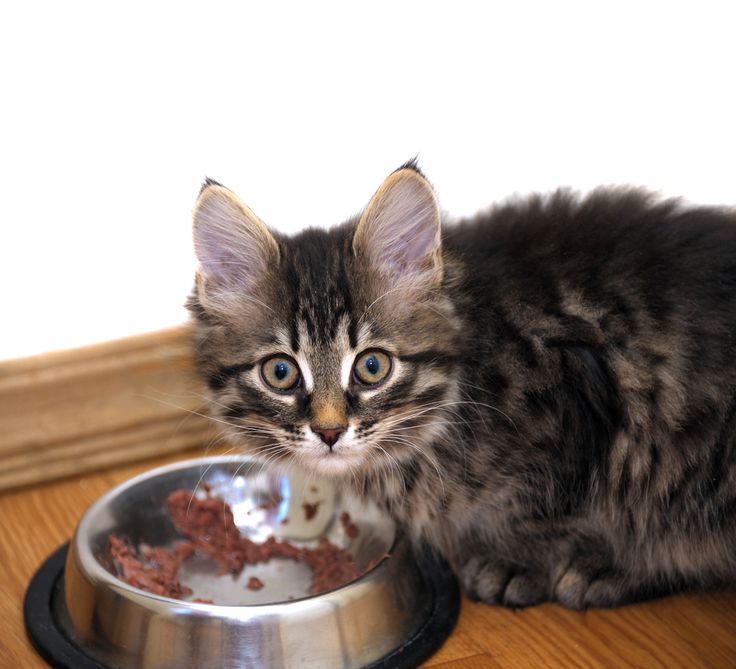 Just like human babies have different nutritional needs than adults, kittens have different dietary requirements than adult cats. With few exceptions, your new feline fur baby is considered a kitten for the first year of life. (Large cat breeds like Norwegian forest cats and Maine coon cats mature more slowly and don’t reach adulthood until they’re 2 years old.) Have you ever asked yourself, “When can kittens eat dry food?” We’ll give you the full scoop on what you should feed your kittens — and when to change their diet.
Just like human babies have different nutritional needs than adults, kittens have different dietary requirements than adult cats. With few exceptions, your new feline fur baby is considered a kitten for the first year of life. (Large cat breeds like Norwegian forest cats and Maine coon cats mature more slowly and don’t reach adulthood until they’re 2 years old.) Have you ever asked yourself, “When can kittens eat dry food?” We’ll give you the full scoop on what you should feed your kittens — and when to change their diet.
Contents
- Do kittens need wet and dry food?
- Is it OK for kittens to eat dry food only?
- When can kittens eat dry food?
- Be cautious when caring for your kitten
Both wet food and dry food are suitable for kittens. However, if you’re feeding a wet food diet, you’ll need to feed your kittens small meals throughout the day to ensure their needs are met. Free-feeding your kittens dry food allows them to eat as often as they want during the day, making it more likely they’ll receive adequate nutrition.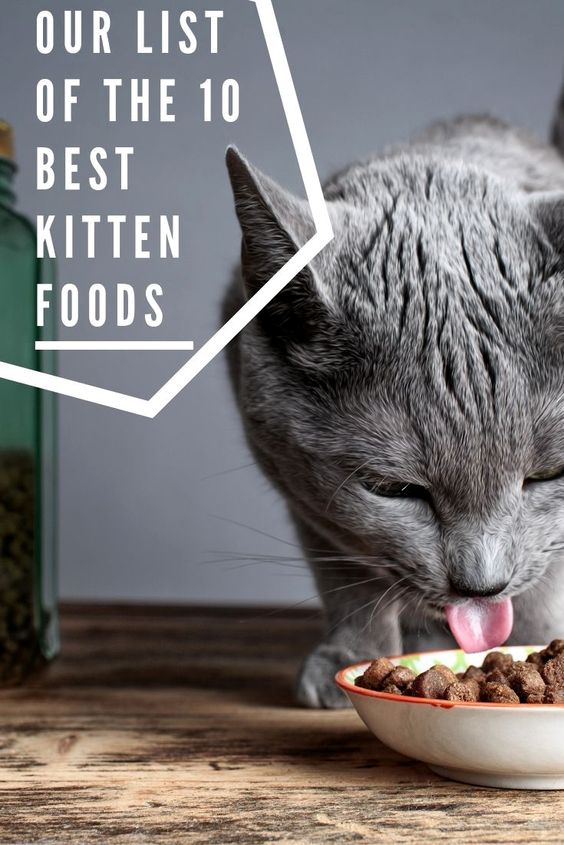 Dry food also helps maintain the health of your kittens’ teeth and gums. Whether you feed your kittens a combination of wet food and dry food, or you decide to stick with dry food only, it’s important to feed your new fur babies a specially formulated diet just for kittens.
Dry food also helps maintain the health of your kittens’ teeth and gums. Whether you feed your kittens a combination of wet food and dry food, or you decide to stick with dry food only, it’s important to feed your new fur babies a specially formulated diet just for kittens.
Kitten food is packed with essential nutrients and minerals to help your little ones grow up healthy and strong. Cats are obligate carnivores, meaning they require meat to survive. Kittens need even more protein than adult cats. They also require amino acids like lysine, methionine, and arginine during the early stages of development. While adult cats require fat, they don’t require as much as young kittens. Fatty acids are essential to support your kittens during the numerous growth spurts they’ll have in the first year of life.
Is it OK for kittens to eat dry food only?According to veterinarian Lauren Jones, feeding kittens dry food only is perfectly acceptable as long as you choose the right food. Dr. Jones says, “Dry food only diets are perfectly fine for kittens, provided that you are offering a diet formulated for growth, like a kitten or all life stage diet.” Dr. Jones also recommends mixing your kittens’ old food with their new food for the first five to seven days. The gradual transition makes it easier for your kittens’ delicate digestive systems to adjust to their new food.
Dr. Jones says, “Dry food only diets are perfectly fine for kittens, provided that you are offering a diet formulated for growth, like a kitten or all life stage diet.” Dr. Jones also recommends mixing your kittens’ old food with their new food for the first five to seven days. The gradual transition makes it easier for your kittens’ delicate digestive systems to adjust to their new food.
Ensuring your kittens get the vital nutrients they need from their diet is essential for their growth and development. According to animal sanctuary and activism group Best Friends, kittens should be exclusively nursed or bottle-fed for the first month of life. Here’s what a general feeding schedule should look like:
Birth to 3 weeksYou’ll need to bottle-feed your kittens between eight and 12 times per day — roughly every 2 to 3 hours — during the first week of life. When they reach 2 weeks old, you can reduce the number of feedings to eight bottles a day (every 3 hours).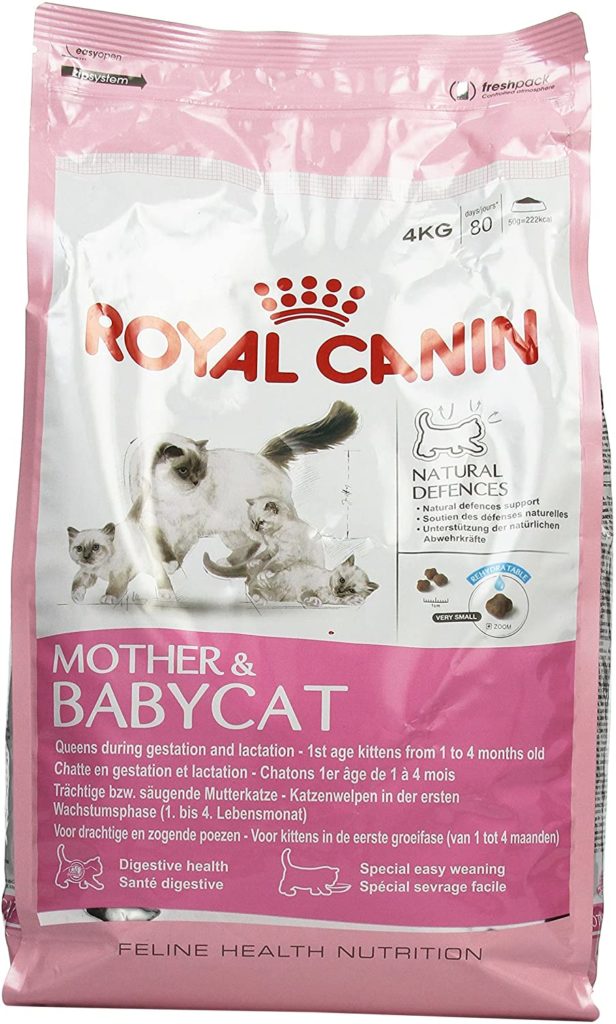 At the 3-week mark, you can begin stretching out feedings to every 4 hours, or six feedings a day, until they’re a month old.
At the 3-week mark, you can begin stretching out feedings to every 4 hours, or six feedings a day, until they’re a month old.
When your kittens reach 4 weeks of age, you can begin weaning them by giving them gruel — a mixture of wet kitten food and kitten formula. Because kittens’ deciduous canine teeth start to erupt around this time, your fur babies will be able to chew their food at this age. Feeding them baby kitten food at this stage provides them with the perfect means of adjusting to their growing chompers. You should continue bottle-feeding your kittens every 8 hours, or three times a day, in addition to giving them access to gruel and baby kitten food at all times. Your kittens should have access to fresh, clean water at all stages of life.
5 to 6 weeksNow is the perfect time to begin transitioning your kittens away from gruel and formula. Mix dry kitten kibble with their wet food to make it easier for your kittens to eat.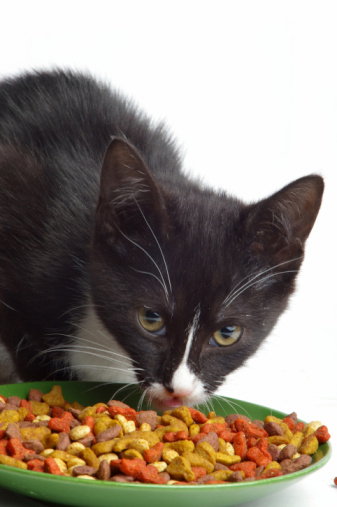 (It’s also easier on their digestion during the transition phase.)
(It’s also easier on their digestion during the transition phase.)
It’s time to gradually decrease the amount of wet food you mix into your kittens’ dry food if you intend to transition them to a dry-only diet. You can still feed your kittens wet food as a treat — or to help them gain weight if they need it — but kittens should have constant access to dry kibble to make sure their dietary needs are met.
Be cautious when caring for your kitten
Figuring out what to feed kittens at each stage of life can be daunting. Fortunately, our helpful list — compiled using expert guidance — can make the process much easier. You may have to try different brands of kitten food to find one your kittens enjoy, but as long as it provides the essential protein, fat, and amino acids your kittens require, you’ll be able to keep your fur babies healthy and happy.
Editors' Recommendations
- Watch out for these telltale signs of rabies in cats: What every pet parent needs to know
- Loss of weight in cats can be a symptom of many things – Here’s what you need to know and when to call the vet
- Thyroid issues in dogs: These are the telltale signs you should consult a vet
- Aquatic turtles: Care and feeding basics every Testudine enthusiast needs to know
- Diabetes in dogs: The risk factors and symptoms all pet parents need to know
When can a kitten be given dry food
The appearance of a new friend in the family is always happiness. A small lump brings warmth and comfort to the house, as well as an important question: how to feed a kitten? You need to monitor the nutrition of the baby from the first days of life. And the most crucial moment is the transition of the kitten from wet food to dry food.
A small lump brings warmth and comfort to the house, as well as an important question: how to feed a kitten? You need to monitor the nutrition of the baby from the first days of life. And the most crucial moment is the transition of the kitten from wet food to dry food.
After birth, the mother takes care of the nutrition of the kitten. Colostrum, and later mother's milk, is a natural and healthy food for kittens up to 2 - 2.5 months. Cat's milk contains twice as much fat as cow's milk, and contains about three times more protein. With such nutrition, the kitten will receive everything necessary for healthy growth and development.
If for some reason the cat does not have the opportunity to feed the litter, or there is not enough milk, there are worthy analogues in pet stores. The sucking reflex in a kitten appears even in the womb, so any responsible owner will be able to feed the kitten on their own. Veterinarians do not recommend preparing a nutrient mixture for a kitten yourself, because the kitten's digestive system is sensitive, and immunity is just beginning to form. ROYAL CANIN Babycat Milk is suitable for kittens from the first birthday up to 2 months. It comes with a feeding bottle and instructions. With this kit, you can feed your kitten up to 1-2 months before switching to dry food.
ROYAL CANIN Babycat Milk is suitable for kittens from the first birthday up to 2 months. It comes with a feeding bottle and instructions. With this kit, you can feed your kitten up to 1-2 months before switching to dry food.
Complete transition to dry food is possible after 2 months from the date of birth of the kitten. However, the transition requires careful preparation. The first, still milk incisors, appear in kittens for 2-3 weeks of life. At 3-4 weeks, fangs appear in kittens. From now on, you can add dry food to your little pet's diet. At this time, it serves only as an addition to the main diet, so that the kittens get used to solid food. It is not necessary to soak the food in water or milk, even the milk teeth of a kitten will perfectly cope with this food. The only important point is the size of the croquettes. Dry food should be just for kittens. You can not give the kitten food for adult cats, because it can simply choke on large granules. Not to mention, the nutritional needs of kittens and adult cats are different.
If the kittens show no interest in dry food, you may need to wait a little longer. The decisive signal will be the moment when the kittens begin to gnaw on the surrounding objects. This is a natural reflex that helps kittens explore the world. From this period, you can definitely start the transition to a new, dry kitten food.
Choosing the right dry food for a kitten
In every pet store you can find lines for adult cats and lines for kittens. The rulers are divided among themselves for good reasons: the size of the granules and the energy value.
Despite their modest size, a kitten needs more energy than an adult cat. Up to a year, a kitten's skeleton is formed, muscle mass grows, teeth are renewed and immunity is established. Babies are generally more active and mobile. All this requires energy, which the little fidget receives from the feed. On average, a kitten needs 25% more calories than an adult cat. If you feed a kitten with adult cat food, he may experience a lack of energy. As a result, problems with the formation of the skeleton, teeth, immunity or muscle mass. Therefore, in the first months of life, the kitten should eat special food.
If you feed a kitten with adult cat food, he may experience a lack of energy. As a result, problems with the formation of the skeleton, teeth, immunity or muscle mass. Therefore, in the first months of life, the kitten should eat special food.
However, there are exceptions - Super Premium and Holistic. Many of these diets can be included in the diet from 2-3 months. So, for example, GO food can be given to a kitten from 2 months of age. A lower calorie content in this case is solved by increasing the portion for the kitten, according to the feeding norms. But why not do this with economy and premium food? It's all about the calorie sources. In premium feeds, meat occupies up to 20% of the composition. The rest of the feed can be vegetables and cereals. With an increase in the volume of a portion of the economy segment feed, the pet will eat more cereals, and only a little more meat. Such a diet is contraindicated for a baby whose body is just being formed. At the same time, Akana feeds contain up to 60% meat, and legumes serve as a source of carbohydrates in them. This food is biologically compatible with the cat's natural diet.
This food is biologically compatible with the cat's natural diet.
The composition will help you determine if a given food is right for your kitten. Earlier we wrote about what modern feeds consist of and how they are produced. The principles for selecting ingredients in kitten food are the same as for adult cats. The special needs of a kitten include an increased protein content. Make sure that the meat in the composition goes on the first line. It is also recommended to avoid foods that contain by-products and meat ingredients, indicated in general terms, without a percentage. For example, the line "meat and offal of animal origin" should alert the responsible owner. If the manufacturer included lamb fillet in the feed, he would openly write about it. The silence of the ingredients suggests that the meat in the feed is far from being of the highest quality. If for an adult cat such a diet can be called acceptable, then the kitten's weak digestive system may not be able to cope with the digestion of offal.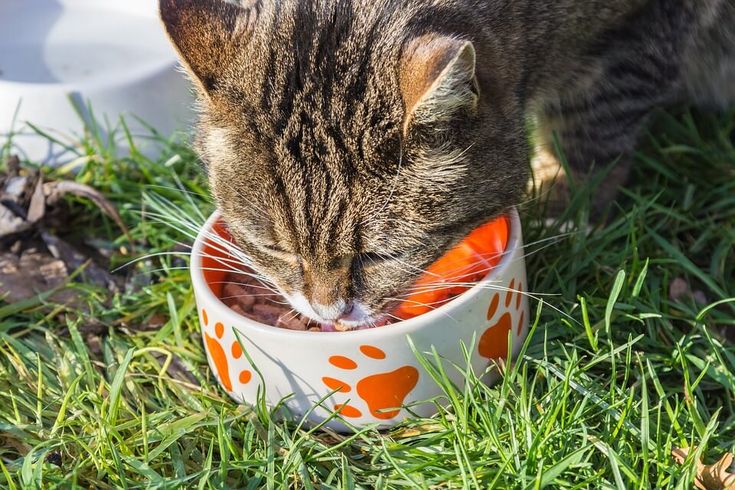 From here, the kitten may have vomiting and problems with the stool.
From here, the kitten may have vomiting and problems with the stool.
When choosing a dry diet for a kitten, it is better to immediately think about what brand of food you want to feed your pet in the future. Indeed, upon reaching one year, the kitten will have to switch to food for adult cats. Lines of 90% of manufacturers have food for both adults and kittens. The transition between two lines is easier if they are the same brand of food.
How to accustom a kitten to new food
The basic principle is simple - you need to smoothly introduce dry food into the kitten's diet, observe the results and increase the amount of dry food in the diet. Carefully monitor the reaction of the kitten's body and adjust the diet in accordance with it. So the pet can easily switch to dry food.
What happens if you completely replace the diet with dry food?
A kitten can completely switch to dry food only after reaching a certain age. As a rule, it is 2-3 months. The food itself, to which the pet passes, is also important. It must be complete.
As a rule, it is 2-3 months. The food itself, to which the pet passes, is also important. It must be complete.
It is not recommended to transfer a kitten under 2 months to dry food, even if you soak it with water. It's all about the needs of the kitten during this period. Until 2 months old, a kitten needs a lot of energy from food. He can get it from his mother's milk or kitten formula. Both those and others contain much more protein and fat as a source of energy. If the kitten switches to dry food before the end of the feeding period, he may have developmental problems.
A kitten that has reached the age of two months can be safely transferred to a complete dry food diet. It contains enough nutrients for a full life and growth. The main thing is that the food is formulated specifically for kittens, or, in the case of holistics, shown to kittens from two months of age. Also, you can not transfer the kitten to dry food in one day. This process requires attention and should be carried out for at least a week.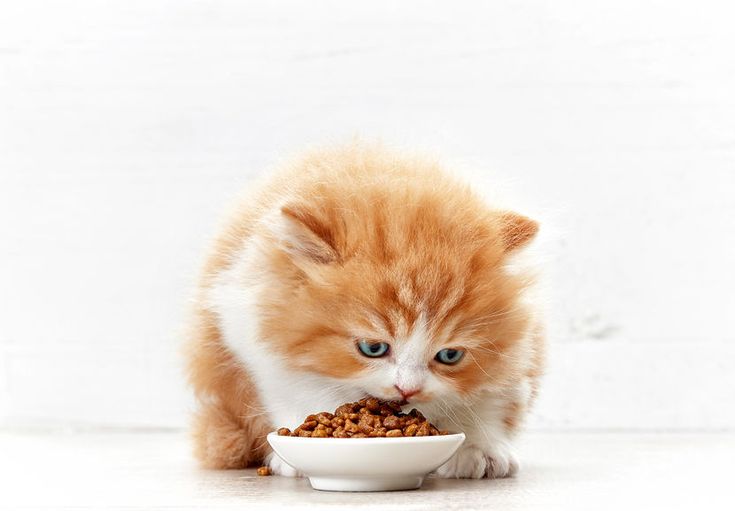 It is necessary to gradually introduce dry food into the feed ration and reduce the number of milk intakes.
It is necessary to gradually introduce dry food into the feed ration and reduce the number of milk intakes.
“There is an opinion that ready-made diets, in particular dry food, somehow stimulate the appearance of urolithiasis. Actually it is not. On the contrary, ready-made diets are balanced in terms of the content of proteins, fats, minerals, microelements and are aimed at preventing urolithiasis,” Vasily Shilov, Candidate of Veterinary Sciences.
Modern dry food does not cause dehydration or digestive problems. They don't need to be soaked. The main thing is that the cat has constant access to a bowl of water. Therefore, after reaching two months, you can safely switch to only dry food.
« High-quality dry food contains a lot of meat or fish, a balanced complex of vitamins and minerals, taking into account the age and health of the animal. This food is suitable as a permanent diet, and there is no need to add canned food to it”,
– Vastab PetCity clinic veterinarian Rannamõisa Marja Roosileht.
However, to diversify the diet, you can periodically include wet food in his diet. It's great if the brands of your dry and wet food are the same. If the manufacturer that produces the line of dry food does not have a wet food, look towards super-premium and holistic wet food. As a rule, they are 60-80% meat and will not harm the pet.
PlanetaZOO recommends
The choice of dry food for a kitten depends on its growth and further development. A small organism is sensitive to nutrition, and therefore the choice of food should be approached with all responsibility. A selection from Planet ZOO will help you navigate among manufacturers and not get confused when choosing food in pet stores.
1. Mr. Buffalo
Premium complete food. The main source of protein in the feed is chicken meat (36%), and carbohydrates - whole grain rice. The food strengthens the immunity of babies, increases resistance to diseases. B Due to the high meat content, the food is easy to digest and assimilate, has excellent taste and is suitable even for picky pets.
B Due to the high meat content, the food is easy to digest and assimilate, has excellent taste and is suitable even for picky pets.
2. Brooksfield
Super premium food from sunny Italy. As part of 57% of meat ingredients, hypoallergenic rice acts as a source of carbohydrates. The food is rich in vitamins due to the addition of fruits and vegetables. Suitable for both pregnant cats and kittens from one month old. It turns out that by buying a large pack you can feed both mother and kitten. A good option in terms of price - quality.
3. Royal Canin
Premium food with the widest range for babies. Babycat Milk is a milk that can be given to a kitten from birth up to 2 months. Mother & Babycat (mousse) wet food, 2 to 4 months. Dry food of the Kitten series, for feeding kittens up to a year. Thanks to a wide range of products, you will be able to smoothly transfer a kitten from a wet type of food to a dry one. This is the brand of food recommended by most breeders.
4. Karmy
Premium food from Russia. Promotes a healthy and improved digestive system, allowing your kitten to grow up strong, active and healthy.
Is it possible to give dry food to kittens, how to feed dry food to a small kitten
Mother's milk is the only food for kittens from the first days of life, but already at the age of four weeks, babies need additional food. By this age, they have milk teeth, and they are quite ready to start eating solid food. So it is quite possible to feed a kitten with dry food from the age of 1–1.5 months, moreover, when choosing a quality diet, this is the best way to raise a healthy and beautiful cat.
Which food is suitable for a kitten?
Even the smallest and most touching fluffy ball is a real predator by nature, which needs food rich in animal protein. Only meat is a complete food for cats, from which their body extracts all the nutrients, vitamins and trace elements it needs.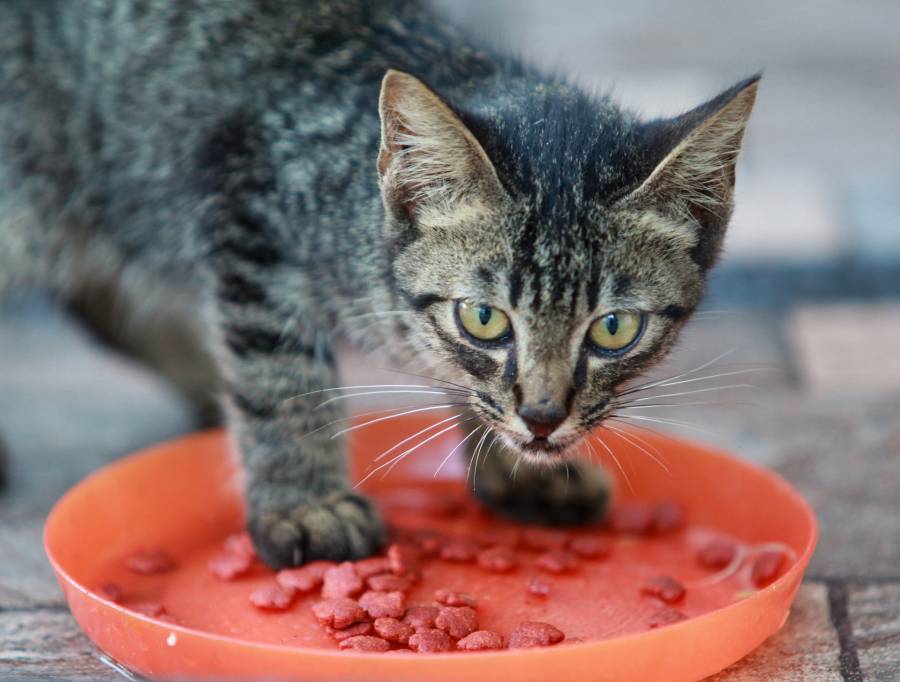 Therefore, when choosing a feed, one should focus on the content of meat ingredients - there should be more of them in the composition than any other components.
Therefore, when choosing a feed, one should focus on the content of meat ingredients - there should be more of them in the composition than any other components.
In addition, you should pay attention to animal fats - replacing them with vegetable oils is unacceptable, since the body of carnivores will not be able to get valuable Omega-3 polyunsaturated fatty acids from the latter, which are important for the formation of the brain and nervous system of kittens. Read more about the selection criteria in the article "What kind of dry food to feed a kitten."
Can kittens be fed dry food with water?
Not only is it possible, but at first it is even necessary to soak dry kitten food with warm water. As we have already said, a kitten can switch to adult food already at the age of one month, but his milk teeth have not yet grown strong, and his jaws are not strong enough, so it will be easier for him to eat slightly softened granules. In addition, moistened food smells stronger and attracts kittens more.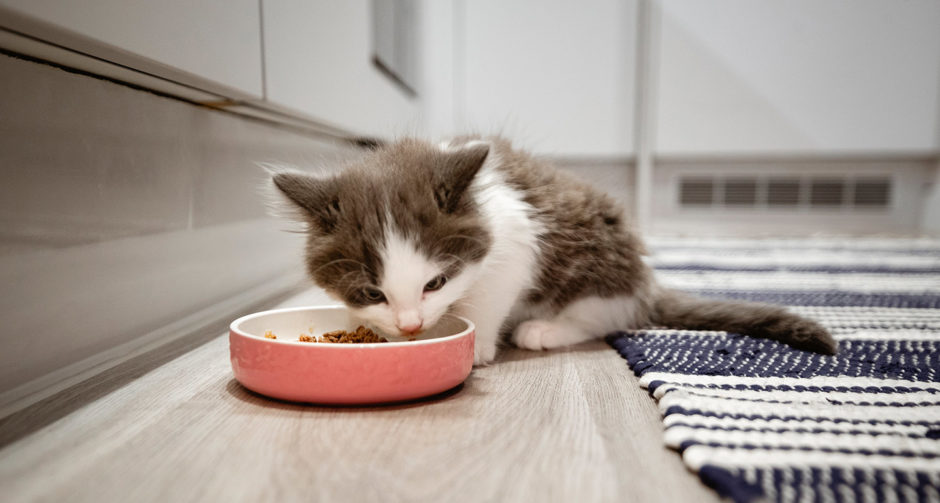 Learn how to soak dry food here.
Learn how to soak dry food here.
How much dry food does a kitten need?
A kitten's need for nutrients is greater than that of an adult animal, because its body spends a lot of energy on growth and development, so the daily norms of dry food for kittens are higher.
Kitten-only diets tend to be higher in calories and higher in animal protein, but there are also versatile foods that can be fed to animals of all ages. These include Acana and Orijen brands - they initially consist of 75-85% meat ingredients, and they do not require special improvements to meet the needs of growing babies, just increase the daily rate.
On each package of our food you will find a table, according to which you can easily calculate how much dry food to give a kitten per day. If you have any difficulties, you will find detailed instructions in this article.
We recommend that you follow the feeding norms and make sure that the kitten always has clean fresh water, since when eating dry food it is very important that the pet consumes enough fluids.